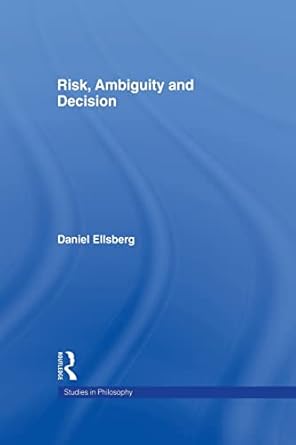
Prime Free Trial
Unlimited Premium Delivery is available to Amazon Prime members. To join, select "Yes, I want unlimited Premium Delivery with Amazon Prime" above the Add to Basket button and confirm your Amazon Prime free trial sign-up during checkout.
Prime members enjoy:- Free delivery of millions of products
- Instant streaming of thousands of films and TV episodes (with limited ads)
- Free in-game content and secured photo storage

Download the free Kindle app and start reading Kindle books instantly on your smartphone, tablet or computer – no Kindle device required.
Read instantly on your browser with Kindle for Web.
Using your mobile phone camera - scan the code below and download the Kindle app.

Risk, Ambiguity and Decision Paperback – 3 Mar. 2016
Purchase options and add-ons
- Print length336 pages
- LanguageEnglish
- Publication date3 Mar. 2016
- Dimensions15.19 x 1.93 x 22.91 cm
- ISBN-101138985473
- ISBN-13978-1138985476
Safety and product resources
Issue loading the information
- Product safety imagesManufacturer informationResponsible person
Issue loading the information
Issue loading the information
Issue loading the information
Product description
Review
"Ellsberg's dissertation is a major landmark in the history of decision research. The issues that it raised and clarified have inspired scholars for decades, and will continue to do so." -- Daniel Kahneman, Princeton University
"I think a published version would be a valuable resource, not only as a historical document, but also for still fresh ideas." -- Dick Jeffrey, Princeton University
"Daniel Ellsberg set the world of decision theorists on its ear when he introduced the distinction between risk and ambiguity in his article excerpted from his dissertation. The clear convincing example caused a fundamental shift in thinking and in many ways led to the subsequent studies of decision and judgment by cognitive psychologists which, in turn, are having an increasing influence in the analysis of economic phenomena. It is good to have the complete text available to us at last." -- Kenneth J. Arrow, Stanford University, Emeritus
About the Author
Daniel Ellsberg was a strategic analyst with the RAND Corporation, and a defense department and state department official who served in Vietnam. He later revealed to the U.S. Senate and the press the Pentagon Papers, a 7,000 page top secret study of U.S. decision making in Vietnam from 1945 to 1968. For this he faced a trial and a sentence of 115 years in prison, but all charges were dismissed on grounds of gross governmental misconduct against him, which led to the conviction of a number of White House aids and figured in the impeachment proceedings against President Nixon.
Product details
- Publisher : Taylor & Francis Ltd; Eerste editie (3 Mar. 2016)
- Language : English
- Paperback : 336 pages
- ISBN-10 : 1138985473
- ISBN-13 : 978-1138985476
- Dimensions : 15.19 x 1.93 x 22.91 cm
- Customer reviews:
Customer reviews
- 5 star4 star3 star2 star1 star5 star39%31%29%0%0%39%
- 5 star4 star3 star2 star1 star4 star39%31%29%0%0%31%
- 5 star4 star3 star2 star1 star3 star39%31%29%0%0%29%
- 5 star4 star3 star2 star1 star2 star39%31%29%0%0%0%
- 5 star4 star3 star2 star1 star1 star39%31%29%0%0%0%
Customer Reviews, including Product Star Ratings, help customers to learn more about the product and decide whether it is the right product for them.
To calculate the overall star rating and percentage breakdown by star, we don’t use a simple average. Instead, our system considers things like how recent a review is and if the reviewer bought the item on Amazon. It also analyses reviews to verify trustworthiness.
Learn more how customers reviews work on Amazon




